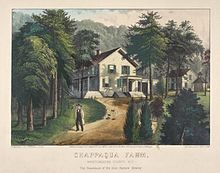Tributes to Horace Greeley
The following are among the tributes to Horace Greeley, editor of the New-York Tribune and 1872 presidential candidate:
Legacy and cultural references[]
Places Named After Greeley[]
- Places named after him include: Greeley, Pennsylvania, Greeley, Colorado, , Greeley, Kansas, Greeley County, Kansas (where there is also a city of Horace, and the county seat is Tribune), and Greeley County, Nebraska (which also has a town named Horace). Horace Greeley High School in Chappaqua, New York, where his house is located, is also named after him.
- Horace Greeley High School in Chappaqua is named for him. Paying homage to the 19th-century paper owned by Greeley, the high school named its newspaper the Greeley Tribune.
 Greeley Square, NYC |
 |
 City Hall Park |
- Horace Greeley Square is a small park in the Herald Square area of Manhattan featuring a seated statue of Greeley designed by Alexander Doyle and was dedicated in 1890. The park is next to the site of the former New York Herald building. There is a second seated statue of Greeley in Manhattan, this one in City Hall Park downtown.
- Mount Horace Greeley is one of the highest points in the Keweenaw Peninsula of Michigan.
Miscellaneous[]
- The Greeley House in Chappaqua, New York, now houses the New Castle Historical Society. The Greeley House was added to the National Register of Historic Places in 1979.[1]

- In 1856, he designed and built Rehoboth, one of the first concrete structures in the United States.[2]
- In the Publisher's Announcement in Volume III of Johnson's New Universal Cyclopaedia, A.J. Johnson stated, "the latest labors of Mr. Greeley's life were given to this work, to which he contributed largely. It is with justice, therefore, that his name is preserved in the list of its editors." Horace Greeley is listed as the editor for the topics American History, Statistics, Agriculture, etc.
- The New York Tribune building was the first home of Pace University. Today, the site where the building stood is now the One Pace Plaza complex of Pace's New York City campus. Coincidentally, Choate House, Dr. Choate's residence and private hospital, where Horace Greeley died, today is part of Pace's campus in Pleasantville, New York.
- On February 3, 1961, the US Post Office Department issued a 4-cent Horace Greeley Famous American stamp designed by Charles R. Chickering through the Chappaqua, New York, post office.[3]

issue of 1961
- Greeley's birthplace is featured on a New Hampshire historical marker (number 3) along New Hampshire Route 101 in Amherst.[4]
- Horace Greeley is the subject of an anecdote recounted by Mark Twain in his lectures to the public after his return from the Sandwich Islands. The story is also retold in Roughing It. In the story, which is really a story about a story, the narrator tells of coming west on the Overland Stage and how at almost every stop someone would board the stage and, after a while, offer to tell the same humorous anecdote about Horace Greeley. It is an example of redundancy or recursiveness as a humoristic story-telling device.[5][6]
- Hjalmar Schacht (full name: Hjalmar Horace Greeley Schacht) was named after Greeley.
- Greeley's experience in the Pike's Peak Gold Rush and the early days of Denver is the basis of the 1965 episode "The Great Turkey War" of the syndicated television series, Death Valley Days. Parley Baer, popular character actor, was cast as Greeley, with Michael Constantine as Pollock. In the story line, a fledgling Denver is wracked by vandalism and the theft of turkeys, and Greeley is determined to tell the truth to the nation via his reporting.[7]
In fiction[]
- Horace Greeley is depicted in the film Gangs of New York (2002) by Michael Byrne in his capacity as publisher of the Tribune.
- Horace Greeley appears in Morris' comic book Lucky Luke in The Daily Star album. Lucky Luke helps a young editor, Horace Greeley, to set himself up in Dead End City and to establish his newspaper, The Daily Star.
- A character named Horace Greeley was a regular in series 5 of the BBC mystery series Jonathan Creek.
- He is also referenced by the character Archer of the cartoon of the same name in the episode "Skin Game."
- In the Broadway play Newsies his name is mentioned.
- Davidson Clark portrayed him in the film The Mighty Barnum (1934)
- Ian Wolfe portrayed him in the film Abe Lincoln in Illinois (1940)
- Rob Roy portrayed him in the film Barnum (1986)
References[]
- ^ "National Register Information System". National Register of Historic Places. National Park Service. March 13, 2009.
- ^ Walter J. Gruber and Dorothy W. Gruber (March 1977). "National Register of Historic Places Registration:Rehoboth". New York State Office of Parks, Recreation and Historic Preservation. Archived from the original on 2011-12-04. Retrieved 2010-12-24.
- ^ "Horace Greeley Issue". Smithsonian National Postal museum. Retrieved Sep 12, 2013.
- ^ "List of Markers by Marker Number" (PDF). nh.gov. New Hampshire Division of Historical Resources. November 2, 2018. Retrieved July 5, 2019.
- ^ Charles Neider (ed.). "Chapter 28". Autobiography of Mark Twain.
- ^ Twain, Mark. "Chapter 20". Roughing It.
- ^ "The Great Turkey War". Internet Movie Data Base. October 7, 1965. Retrieved August 29, 2015.
Categories:
- Horace Greeley